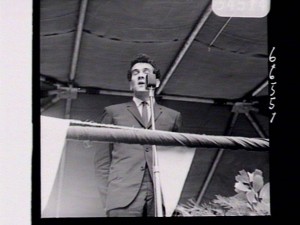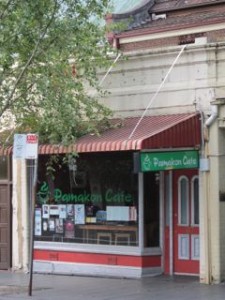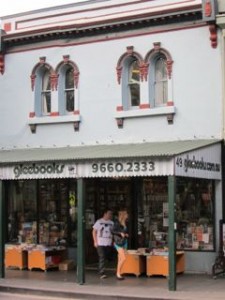Aboriginal and pro-Aboriginal activism; Women’s Liberation; radical writing and book culture.
A talk in the Glebe Society’s Glebe Voices series, 22 February 2012, Blackwattle Bay Café.
© Copyright Ann Curthoys.
Thank you to Mairéad and the Glebe Society for inviting me to talk about Radical Glebe. I moved back to Glebe about a year ago, after an absence of 37 years, having formerly lived in Sheehy Street while completing my PhD thesis. I have strong memories of writing that thesis overlooking Blackwattle Bay, as a warehouse for containers was being built, long before the current housing complex in Griffin Place.
I realised when invited to give this talk that my association with Glebe and its radical politics and intellectual life is much more than as a former and current resident. Glebe of course is not just a suburb, but rather a precinct that is part of a larger area, bounded by several educational institutions, most notably the University of Sydney and what is now UTS, and my talk about radical Glebe will inevitably include those two institutions, at both of which I’ve been an academic and Sydney also as a student.
Glebe of course has a huge radical history, with many different dimensions. Some of them are discussed in Terry Irving and Rowan Cahill’s book, Radical Sydney. They draw attention to working class Glebe politics and its role in major events such as the anti-conscription marches of 1916 and 1917, the General Strike of 1917, the Timber Workers’ Strike of 1929, the Unemployed Workers Union, and the controversial Youth Carnival for Peace and Friendship in March 1952. And of course there is the radicalism of the resident action groups such as the Glebe Society itself, from its beginnings in 1969, protesting against proposed expressways and high rise development.
But today I want to focus on those aspects of Glebe’s radical history that I know personally, starting in the mid-1960s and ending in the mid-1990s. I have, I think, three major themes. The first is Aboriginal and pro-Aboriginal activism in the 1960s, and its connections with Glebe. The second is the emergence of Women’s Liberation in the 1970s. And the third is Glebe as a centre for radical writing and book culture generally, from the 1970s to the 1990s, and of course, still today.
The Freedom Ride

State Library of NSW
The Freedom Ride of 1965 emanated from the University of Sydney, and I’ve written about it in my book, entitled Freedom Ride: A Freedom Rider Remembers. The students involved lived all over Sydney, and in fact at that stage I lived in a flat in Bondi, but Charles Perkins, the most famous participant, lived in Catherine Street in Forest Lodge, and some crucial organising and preparation meetings were held at his house. That same year, 1965, Charles was still living there when he attempted to prevent the deportation of Nancy Prasad, ‘kidnapping’ her at the airport and taking her back to his house. (Glebe, of course, was already a centre of Aboriginal activity, with the establishment of Tranby as a training college for Alf Clint’s Aboriginal Cooperative Movement in 1958 at 13 Mansfield Street.)
The Freedom Ride is I think part of Glebe’s radical history, which is inevitably intertwined with that of the University of Sydney, as students rented cheap shared housing, drank at the Forest Lodge hotel, and organised radical demonstrations and marches. The middle 1960s was just at the beginning of the rise of student radicalism, and students were to become much more radical in the second half of the decade, involved in the campaign opposing Australia’s involvement in the American war in Vietnam, and more broadly in the New Left. The Freedom Ride brought together this emerging student radicalism with a form of Aboriginal politics that had been growing through the 1950s and into the 1960s which tended to be more moderate in its political style.
Women’s Liberation
My strongest connection with Glebe’s radical history is probably with the establishment of Women’s Liberation house at 67 Glebe Point Road. Some small Women’s Liberation groups had been meeting in Glebe and Balmain since April 1969, but Women’s Liberation really started to grow in 1970 when 67 Glebe Point Road became available through Barbara Levy.

I was one of the women who flocked to the house as part of the new women’s liberation movement. The front room downstairs was the meeting room, and behind that the newspaper room. Some of the people there included Lesley Lynch, Sandra Hawker, Martha Ansara (an American filmmaker), Coonie Sandford (another American), Lyndall Ryan, Camille Guy (a New Zealander) and Mary Murnane, and many more. At the meetings we discussed some of the basic ideas of women’s liberation. What I really remember is the idea that your personal feelings of inadequacy were not because you were inadequate but because society made you as a woman feel inadequate. It was all about looking outside yourself to see how you were socially constructed. The other central idea was that women tend to look for male approval and don’t seek or value solidarity with other women. From these two basic points all sorts of other ideas emerged, for instance analyses of the importance of women having financial independence, of the relationship between the workforce and family life, of male objectification and fundamental disrespect for women, and a growing emphasis on women’s cultural expression, and much else. All these came out of those meetings.
At the time, I was a postgraduate student at Macquarie University and many others were about my age, in our mid twenties. But there were many older women as well, who had had quite different life experiences from us, so those exchanges were life changing for all of us.
Very important in the development of our ideas was our reading of key overseas texts that came out in 1970 and 1971. Especially important among these new texts were Kate Millett’s Sexual Politics, Shulamith Firestone’s The Dialectic of Sex, Germaine Greer’s The Female Eunuch, and Juliet Mitchell’s Woman’s Estate. There many others as well, such as Robin Morgan’s Sisterhood is Powerful: An Anthology of Writings from the Women’s Liberation Movement (1970) with its instantly classic essays such as Pat Mainardi’s The Politics of Housework and excerpts from Valerie Solanis’s SCUM (Society for Cutting Up Men) manifesto.
One of the most important aspects of Women’s Liberation as it was in 67 Glebe Point Road was our access to radical newspapers and magazines. In the second room downstairs you could browse and read all kinds of recent journals. Access to the American journals was probably through the Americans, especially Martha Ansara. A listing of women’s liberation literature put out by the Glebe group in 1971 gave the American addresses of relevant journals and pamphlets, such as Tooth and Nail, Off the Pedestal, Off Our Backs, Socialist Woman, Women’s Monthly, Bread and Roses Newsletter, It Ain’t Me Babe, Rat, Up From Under, No More Fun and Games, Women Speak Out, Voice of Women’s Liberation, New York Feminist, Women: A Journal of Liberation. It listed also those journals which had special issues on women’s liberation – Ramparts, Radical America, Win, Leviathan, Monthly Review. Contact addresses were also given for a large number of pamphlets.
Despite these daunting reading lists with their helpful American addresses, it was difficult for most Australian women to obtain much of this ephemeral literature, and one of the first things the new group did was duplicate and distribute it extremely cheaply. Secure in the knowledge their authors and publishers would never know, or probably care, these reprints were generally without permission or any regard to copyright. Reprinted in this way during 1969 and 1970, to mention one of the most striking and influential, was Kate Millett’s essay on the works of Mailer, Miller and Genet, which had first appeared in the New American Review in August 1969. (Sexual Politics, whose first chapter it became, was not available in Australia until 1971.) Millett’s essay, with its bold and fearless literary analysis, and its manifesto-like proclamation of a new feminism, was excitedly read for its new ways of thinking about questions of gender and sexuality.
One particularly well-liked American essay was Pat Mainardi’s The Politics of Housework (1970), with its very funny and telling list of male excuses for not doing housework. An example:
‘I don’t mind sharing the housework, but I don’t do it very well. We should each do the things we’re best at.’
Meaning: Unfortunately I’m no good at things like washing dishes or cooking. What I do best is a little light carpentry, changing light bulbs, moving furniture…
Also meaning: Historically the lower classes (black men and us [women]) have had hundreds of years of experience doing menial jobs. It would be a waste of manpower to train someone else to do them now.
Also meaning: I don’t like dull stupid boring jobs, so you should do them.’ (Morgan 1970: 448-9).
These American imports and reprints were soon joined by locally written articles, some of which were extremely derivative of their American sources, many to the point of an unselfconscious plagiarism. This was a culture of energetically soaking up ideas, borrowing, reprinting, reworking, quoting at length, discussing, explaining. A report of the Literature Committee in the Sydney Women’s Liberation Newsletter in 1970 announced that it was ‘re-writing for Australia’ an article from Leviathan called A Woman’s Work is Never Done by Peggy Morton. One of the Sydney group’s best sellers was Tales my mother never told me which demonstrates this process of freely reprinting and rewriting, as well as the beginnings of locally written material. It contained a reprint of Naomi Weisstein’s Psychology Constructs the Female, a rewritten piece by Sydney woman Gale Kelly called The Myth of the Vaginal Orgasm freely borrowed from Anne Koedt’s article of the same name; and a genuinely local article, Anatomy is Destiny, by Camille Guy.
In 1971, I was part of the collective that established the first women’s liberation newspaper in Sydney, and indeed in Australia, called MeJane. The first issue had a picture of me swinging from a tree, meant to represent Jane I suppose, and that was actually photographed outside my house in Annandale that John and I shared with Lyndall Ryan. We compiled the newspaper in 67 Glebe Point Road, using Letraset. One of the things we did was a series on women at work – we interviewed nurses, housewives, machinists, and so on. I also remember interviewing Wendy Bacon, then in the news for her challenges to censorship through her editing of Tharunka, the UNSW magazine, and who had recently spent eight days in the Silverwater Women’s Detention Centre for exhibiting an obscene publication. In fact, this gaol experience led to Wendy’s long association with prisoner’s rights, including the founding of Women Behind Bars. It was also during that time Anne Summers arrived in Sydney from Adelaide, and she became part of the collective from the third issue, and began working on her book, which later became Damned Whores and God’s Police.
At the end of 1972, a number of us started up a feminist journal called Refractory Girl. Anne Summers was the prime instigator. It represented the more academic side of women’s liberation with longer more scholarly articles. The title was suggested by Anne, referring to the women convicts who were supposed to have greeted Lady Jane Franklin by slapping their bare bottoms, though historians now think this event probably never happened. Certainly the female factory site in Hobart, which I visited last week, mentions it but says it did not happen. In any case, the idea of women convicts as resisting authority rather appealed to us. I’m not sure exactly where Refractory Girl was produced.
Women’s liberation groups by this time had spread far and wide, and Glebe became only one of a number of women’s houses and discussion groups . I should also mention that the first women’s refuge, Elsie, was established in Westmoreland Street in Glebe in 1974, though I was not personally involved.
Writing and Intellectual Life

Glebe has also been the centre of radical writing in a number of ways – through the number of writers who have lived here, and especially through the presence since 1975 of Gleebooks. My own connections with Glebe in this sense resumed in 1978, when I returned from three years in Canberra, two of them teaching Women’s Studies at ANU. I took up a lectureship at what was then the New South Wales Institute of Technology, now UTS. NSWIT had a couple of years previously appointed Bill Bonney, a philosopher from the University of Sydney, as head of its Faculty of Humanities, and he had overseen the introduction of a Bachelor of Arts in Communication. The staff were an uneasy mix of people who had been there earlier, teaching courses like professional writing and communication psychology, with the people Bill appointed, who were younger, more radical, many of them Marxist, and much more aligned to media production – in film, in writing, and radio. Bill and those closest to him saw the media as a place for resistance and change – if you influenced the media you could change society, and so the courses were very left wing in content. As you might expect, there were huge conflicts between the two groups of staff, until eventually Bill was removed from the position of Dean. On the initiative of Justice Hal Wootten, the new Chancellor, there was a university inquiry into the troubles, the result of which was the retention of the Faculty and eventually the appointment of Gunther Kress, a linguist, as permanent head. With Gunther’s arrival, peace was more or less restored. Many staff left during these troubles and many new ones arrived so that the old cleavages became less clear.
These were crazy times indeed. One of the aspects of the degree was a heavy emphasis on mature age entry, and many of the students who did the degree were in their twenties and thirties and had some experience in the media. Many of them lived in Glebe, and the interaction of Glebe-based students and a radical cohort of staff in the Faculty helped create a particular radical culture interested in film, print journalism, radio, and writing. In the 1980s the students were undergraduates or perhaps Diploma of Communication students – by the 1990s they also included Masters and PhD students. In the late 1980s we established a Master of Arts in Writing program which was to prove hugely popular, and which had close associations with Gleebooks.
Conclusion
When I finally returned to Glebe in 2010, I felt I had come home and connections were restored. But of course, nothing stays still, and Glebe has changed a lot. Its radical traditions, however, survive and flourish in various places, including in the Glebe Society itself, and in the work of writers and media artists and producers of various kinds. Glebe remains in touch with inner Sydney’s intellectual and cultural life more generally, connected as it is on one side with the inner west, on another with Ultimo and institutions like the Powerhouse museum and the ABC, and with two major universities. Its coffee shops and cafés hum with on and off campus meetings, intellectual discussions, pitching of ideas, hatching of media, artistic, and political projects, and with casual greetings and intense conversations that suggest a lively and widely connected community.









Join the conversation on Facebook.